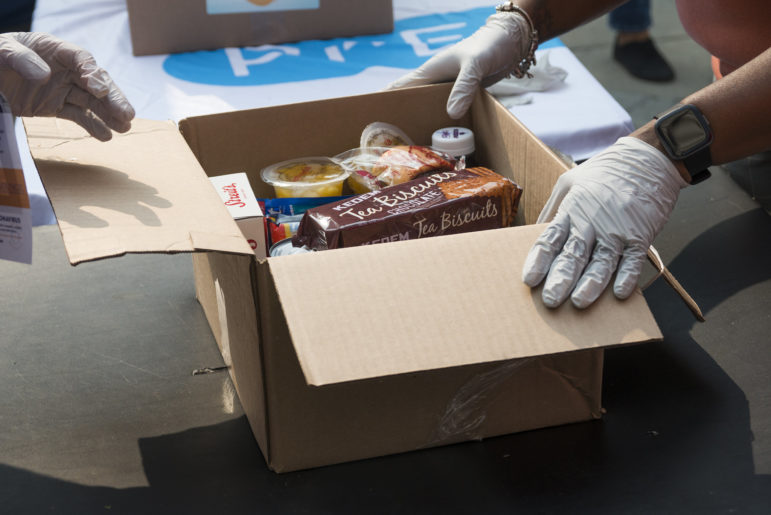‘College campus food pantries have short hours of operation, lack physical space, and regularly run out of food. Already strained, many have been stretched to a breaking point under the current explosion of student hunger.’

Flickr/New York City Council
A pantry box being prepared at a city food giveaway in September.This week, thousands of students are returning to New York’s colleges with a worrying question on their minds. It doesn’t concern tumultuous local politics or even the surge of the Delta variant. Rather, it’s a question that college students have struggled with for years: where will my next meal come from?
From Brooklyn to Buffalo, college campuses have long been a place of significant food insecurity. In 2018, the Hope Center for College, Community and Justice conducted a survey which revealed that 48 percent of City University of New York (CUNY) students struggled with food insecurity. At State University of New York (SUNY) community colleges, 45 percent of students were unable to focus in class because they were hungry. Those numbers are even higher amid the pandemic, which has disproportionately impacted low-income college students.
Among those students is Suraiya: a recent SUNY Monroe Community College graduate, mother of three, and aspiring homicide detective. When her children’s school transitioned to virtual learning in March 2020, putting enough food on the table for her family became extremely difficult. “When my kids were in school, they would get breakfast and lunch. All I had to provide was dinner. With them home, there are a lot of extra meals to provide,” she shared. And while Suraiya receives Supplemental Nutrition Assistance Program (SNAP) benefits which have helped, a majority of students experiencing food insecurity do not.
 CityViews are readers’ opinions, not those of City Limits. Add your voice today!
CityViews are readers’ opinions, not those of City Limits. Add your voice today!
Generally, college students must work 20 hours per week to be eligible for SNAP benefits—a burdensome requirement many students are unable to meet. Even among those who are eligible, few enroll due to lacking information about the program, confusion around the application process, and stigma associated with accessing public benefits.
In the absence of more accessible federal support, students are often forced to rely on campus food pantries. All public colleges in New York—in compliance with the 2018 No Student Goes Hungry mandate—are required to have a campus pantry or an alternative stigma-free way to distribute free food. Yet campuses received almost no state funding to meet this mandate. They were instead instructed by the governor’s office to use private donations or reallocate funding.
Facing their own budget shortfalls, colleges have generally been unable to adequately invest in these initiatives. Most pantries are run by volunteers and are dependent on inconsistent donations from foundations and nonprofits. They have short hours of operation, lack physical space, and regularly run out of food. Already strained, many campus pantries have been stretched to a breaking point under the current explosion of student hunger.
At CUNY’s Medgar Evers College (MEC), Student Life Specialist Waleek Boone has worked around the clock with a team of only three student volunteers to keep the pantry open throughout the pandemic. They’ve distributed thousands of bags of groceries to students, many of whom recently lost their jobs and are struggling with housing insecurity. “The people who visit are very appreciative. They know we’re risking our lives to help serve them,” Boone said. Without the goodwill of these volunteers, however, this lifeline for hundreds would have been forced to close.
This situation is not unique to MEC. Campus pantries across the state are facing an uphill battle to support students while lacking the resources to do so. And the consequences of not meeting New York’s college students’ basic needs should sound alarm.
When students struggle with basic needs insecurity, their academic performance suffers and they are more likely to drop out of school than their peers. At CUNY alone, thousands of students annually withdraw from college due to the costs of non-tuition expenses like groceries and MetroCards, according to a report by the Center for an Urban Future. These students are then three times more likely to live under the federal poverty line than their former classmates.
The SUNY Food Insecurity Task Force, Healthy CUNY, and advocacy organizations like Swipe Out Hunger emphasize that breaking this vicious cycle will require investing more in pantries as well as other system-wide solutions.
New York’s colleges will be hard pressed to do so without state funding. That’s why bills like the Hunger Free Campus Act—introduced by State Senator Kaplan (D-North Hills) and Assembly Member Rosenthal (D/WF-Manhattan)—are vitally needed. This bill would send millions of state dollars to higher education institutions to help them implement and expand food security programs that best suit the needs of their students, including creating meal swipe donation programs, hiring staff to help students obtain public benefits, and strengthening campus pantries.
We call upon Gov. Kathy Hochul and our legislators in Albany to pass the Hunger Free Campus Act. Providing our resilient students with the resources they need to reach their full potential will allow New York to rebuild as a stronger state where no student goes hungry.
Haley Schusterman is a National Advocacy Fellow at Swipe Out Hunger, an organization that works to combat food insecurity at college campuses.








